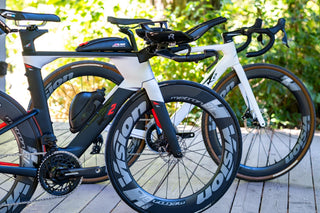We recently got the question of: "Why does road bike geometry seem to accommodate more people than tri bike geometry?"
Fantastic question. Road bike, triathlon bike, gravel bike, mountain bike...the list feels like it can go on and on. All bikes have their own purpose (bike handling, aerodynamics, adaptability, etc.) and specific geometry and features to meet this purpose, but what it really comes down to is what "purpose" is most comfortable for your body.
Today, we're breaking down the main differences between the two bikes that A2 has and the "why" behind it.
Road Bikes
In general, road bikes are made to handle sharper climbs, descents, and corners while triathlon bikes are designed in all ways to be wind-slicing machines.

Road bikes have a higher rider profile than tri bikes, with a shallow seat tube angle and a seat that is set a bit farther back in relation to the pedals. Road bike handlebars also tend to be higher up than triathlon bars (although this can depend on riders and their flexibility) and feature three main hand positions - center/tops, which is ideal for climbing and opens up the rib cage, hoods, the most common riding position over the top ends of the bars near the shifters, and drops, the bottom curve of the bars and best for getting aero and descending.
While this positioning may be higher up and "in the wind" compared to triathlon bikes -- we'll get to that geometry soon -- it matters much less in road bike scenarios, as draft-legal or pack racing largely counters the aerodynamic disadvantages of road bikes compared to triathlon bikes. Plus with road bike geometry, you have the added benefit of being more agile, comfortable, and have the ability to generate more bursts of power on more types of terrain.
This is why we often recommend road bikes to new cyclists or riders who may be less flexible. The bike will be more versatile and allowed in all situations, plus the more upright positioning will feel a bit kinder to necks, shoulders, lower backs and hips.
Triathlon Bikes
In comparison to road bikes, triathlon bikes are focused on aerodynamics. And for this blog post, we are just focusing on triathlon bikes - not time trial bikes, which have to follow UCI rules and are typically made for shorter events (1 hour time trials versus 5+ hour full distance triathlons). For a deep dive into the differences between these bikes, we recommend watching this video from GTN.

So back to tri bikes, which is what the A2 SP falls under: tri bikes have a steeper seat tube and a seat that often sits nearly above the pedals, rotating the hips and decreasing load on quads and hamstrings, which we then use a ton in the run!
The handlebars feature aero bars that rise from a low base bar, allowing athletes to get low and stretch out on the bike compared to in a road position. While "stretching" may sound like a nice position, this flat back position may be more challenging for many to hold for long durations depending on their back, hip and shoulder flexibility. Even for many pros, it may take some time in the beginning of the season to train their body to be able to hold such an aerodynamically aggressive position.
Another important thing to note: brakes are only on the base bars, and require a much larger hand shift compared to road bikes. This is one of the reasons (among others in aero bar handling) why tri bikes are often not allowed in group riding and are banned from draft-legal racing.
Finally, triathlon bikes will always be a stiffer ride than endurance road (or really most road) frames, especially because of the frame's wider profile, This doesn't necessarily change much in the fit, but if you prefer a more nimble ride or comfortable ride, then an endurance road frame may be your best bet.
In short, while aero bars and seat position can be adjusted for the rider, the most aerodynamic fit in triathlon bikes can be less comfortable for some riders and may be limited by personal body mobility.


